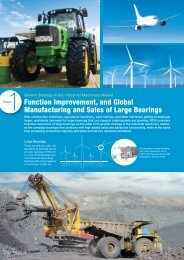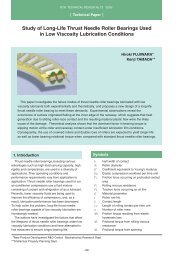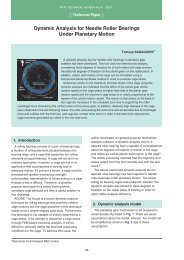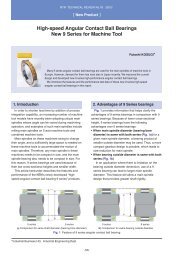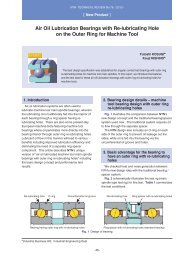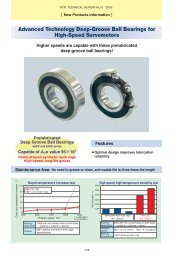Special Issue; Products for Industrial Machinery - NTN
Special Issue; Products for Industrial Machinery - NTN
Special Issue; Products for Industrial Machinery - NTN
You also want an ePaper? Increase the reach of your titles
YUMPU automatically turns print PDFs into web optimized ePapers that Google loves.
Honing Sludge and Electro Furnace Dust Briquetter<br />
Product<br />
Slag<br />
Exhaust<br />
Electric arc furnace<br />
Dust<br />
Scrap<br />
Briquette<br />
150120H<br />
Filter<br />
Dust <br />
Carbon<br />
Water<br />
Pelletizer<br />
Pellets<br />
Iron<br />
content<br />
Dezincification<br />
system<br />
Commissioning to<br />
outside disposal agents<br />
Zinc bullion<br />
Fig. 11 Recycling of EAF (electric arc furnace) dust<br />
<strong>NTN</strong> EAF dust briquetter<br />
carbon, which functions as a reducing agent and fuel,<br />
and the mixture is <strong>for</strong>med into pellets. The resultant<br />
pellets are not suitable <strong>for</strong> direct loading into an<br />
electric arc furnace due to their low mechanical<br />
strength and difficulty in handling. There<strong>for</strong>e, the<br />
pellets are <strong>for</strong>med into briquettes with the authors’<br />
newly developed briquetter, and then the briquette is<br />
loaded into the electric arc furnace. Since EAF dust is<br />
repeatedly recycled, the concentration of zinc, which<br />
has a relatively low boiling point, in the EAF dust will<br />
increase and pose a problem in operating the electric<br />
arc furnace. There<strong>for</strong>e, when the zinc concentration<br />
reaches a specific upper limit, the iron content is<br />
separated from the zinc content. The iron content is<br />
reloaded into the furnace while the zinc content is<br />
recycled as a valuable material.<br />
Thanks to this recycling scheme, the disposal of<br />
EAF dust by landfill, no longer necessary. The number<br />
of zinc removal cycles can be decreased, thereby<br />
dramatically reducing the costs associated with<br />
industrial waste disposal.<br />
3.2 Overview of the authors’ briquetter<br />
1) Formation principle<br />
The principle of this briquette <strong>for</strong>mation method is<br />
schematically illustrated in Fig. 12. The pellets are<br />
loaded into the die, and then the upper and lower<br />
punches apply <strong>for</strong>ce to the pellets in the die to convert<br />
the pellets into a briquette.<br />
Upper punch<br />
Pellets<br />
Lower punch<br />
Die<br />
Fig. 12 Moulding method<br />
2) Effects of various factors on the strength of<br />
briquettes<br />
The authors investigated the effects of factors<br />
associated with materials and <strong>for</strong>mation conditions on<br />
the mechanical strength of the briquettes obtained.<br />
The results of these investigations are shown in Figs.<br />
13 through 16. The mechanical strength of the<br />
briquettes was translated into indexes by dropping<br />
each briquette from 1 meter above to a 5-cm thick<br />
layer of raw material powder and then counting the<br />
number of fractured pieces resulting. The greater the<br />
index is, the greater the mechanical strength of the<br />
briquette. By appropriately selecting the water and<br />
carbon content in the pellets and the <strong>for</strong>mation<br />
-77-




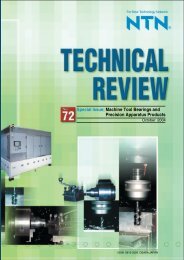
![[New Product] Unit Products for Office Equipment - NTN](https://img.yumpu.com/27154451/1/184x260/new-product-unit-products-for-office-equipment-ntn.jpg?quality=85)
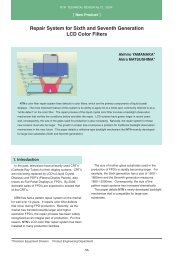
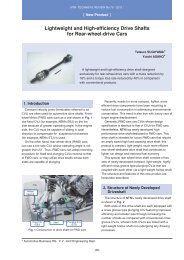
![[New Product] Development of Oil-impregnated Sintered ... - NTN](https://img.yumpu.com/27154427/1/184x260/new-product-development-of-oil-impregnated-sintered-ntn.jpg?quality=85)

